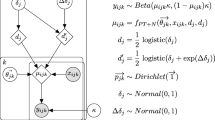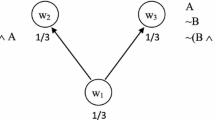Abstract
We propose a theory that relates perceived evidence to numerical probability judgment. The most successful prior account of this relation is Support Theory, advanced in Tversky and Koehler (1994). Support Theory, however, implies additive probability estimates for binary partitions. In contrast, superadditivity has been documented in Macchi, Osherson, and Krantz (1999), and both sub- and superadditivity appear in the experiments reported here. Nonadditivity suggests asymmetry in the processing of focal and nonfocal hypotheses, even within binary partitions. We extend Support Theory by revising its basic equation to allow such asymmetry, and compare the two equations' ability to predict numerical assessments of probability from scaled estimates of evidence for and against a given proposition. Both between- and within-subject experimental designs are employed for this purpose. We find that the revised equation is more accurate than the original Support Theory equation. The implications of asymmetric processing on qualitative assessments of chance are also briefly discussed.
Similar content being viewed by others
References
Baron, J. (1994). Thinking and Deciding, 2nd edition. New York, NY: Cambridge University Press.
Beyth-Marom, R., L. Austin, B. Fischhoff, C. Palmgren, and M. Jacobs-Quadrel. (1993). “Perceived Consequences of Risky Behaviors: Adults and Adolescents,” Developmental Psychology 29, 549–563.
Brenner, L. and Y. Rottenstreich. (1999). “Focus, Repacking and the Judgment of Grouped Hypotheses,” Journal of Behavioral Decision Making 12, 141–148.
Brenner, L. A. and D. J. Koehler. (1999). “Subjective Probability of Disjunctive Hypotheses: Local-Weight Models for Decomposition of Evidential Support,” Cognitive Psychology 38, 16–47.
Briggs, L. and D. H. Krantz. (1992). “Judging the Strength of Designated Evidence,” Journal of Behavioral Decision Making 5, 77–106.
Christensen-Szalanski, J. J. J. and C. F. Willham. (1991). “The Hindsight Bias: A Meta-Analysis,” Organizational Behavior and Human Decision Processes 48, 147–168.
Cohen, J., E. Dearnaley, and C. Hansel. (1956). “The Addition of Subjective Probabilities: The Summation of Estimates of Success and Failure,” Acta Psychologica 12, 371–380.
Edwards, W., H. Lindman, and L. D. Phillips. (1965). “Emerging Technologies for Making Decisions,” In T. M. Newcomb (ed.), New Directions in Psychology II, pp. 265–325. New York: Holt, Rinehart and Winston.
Fiedler, K. and T. Armbruster. (1994). “Two Halfs May Be More Than One Whole: Category-Split Effect on Frequency Illusions,” Journal of Personality and Social Psychology 66, 633–645.
Fischhoff, B. and W. Bruine de Bruin. (1999). “Fifty-Fifty = 50?,” Journal of Behavioral Decision Making 12, 149–167.
Fischhoff, B., P. Slovic, and S. Lichtenstein. (1978). “Fault Trees: Sensitivity of Estimated Failure Probabilities to Problem Representation,” Journal of Experimental Psychology: Human Perception and Performance 4, 330–344.
Fox, C. R. (1999). “Strength of Evidence, Judged Probability, and Choice Under Uncertainty,” Cognitive Psychology 38, 167–189.
Kleindorfer, P., H. Kunreuther, and P. Schoemaker. (1993). Decision Sciences: An Integrative Perspective. New York, NY: Cambridge University Press.
Koriat, A., S. Lichtenstein, and B. Fischhoff. (1980). “Reasons for Confidence,” Journal of Experimental Psychology: Human Learning and Memory 6, 107–118.
Macchi, L., D. Osherson, and D. H. Krantz. (1999). “Superadditive Probability Judgment,” Psychological Review 106, 210–214.
Morgan, M. G. and M. Henrion. (1990). Uncertainty: A Guide to Dealing with Uncertainty in Quantitative Risk and Policy Analysis. Cambridge, UK: Cambridge University Press.
Mulford, M. and R. M. Dawes. (1999). “Subadditivity in Memory for Personal Events,” Psychological Science 10(1), 47–51.
Osherson, D. (1995). “Probability Judgment.” In E. E. Smith, and D. Osherson (eds.), Invitation to Cognitive Science: Thinking, Second edition. Cambridge, MA: MIT Press.
Osheson, D., D. Lane, P. Hartley, and R. Batsell. (in press). “Coherent Probability from Incoherent Judgment,” Journal of Experimental Psychology: Applied., in press.
Osherson, D., E. Shafir, D. H. Krantz, and E. E. Smith. (1997). “Probability Bootstrapping: Improving Prediction by Fitting Extensional Models to Knowledgeable but Incoherent Probability Judgments,” Organizational Behavior and Human Decision Processes 69, 1–8.
Rottenstreich, Y. and A. Tversky. (1997). “Unpacking, Repacking, and Anchoring: Advances in Support Theory,” Psychological Review 104, 406–415.
Russo, J. E. and K. J. Kolzow. (1994). “Where is the Fault in Fault Trees?,” Journal of Experimental Psychology: Human Perception and Performance 20, 17–32.
Savage, L. J. (1954). The Foundations of Statistics. New York, NY: Wiley.
Tversky, A. and C. R. Fox. (1995). “Weighing Risk and Uncertainty,” Psychological Review 102.
Tversky, A. and D. Kahneman. (1974). “Judgment Under Uncertainty: Heuristics and Biases,” Science 185, 1124–1131.
Tversky, A. and D. Kahneman. (1992). “Advances in Prospect Theory: Cumulative Representation of Uncertainty,” Journal of Risk and Uncertainty 1, 297–323.
Tversky, A. and D. J. Koehler. (1994). “Support Theory: A Nonextensional Representation of Subjective Probability,” Psychological Review 101(4), 547–567.
Wallsten, T. (1971). “‘Subjectively Expected Utility Theory and Subjects’ Probability Estimates: Use of Measurement-Free Techniques,” Journal of Experimental Psychology 88, 31–40.
Wallsten, T., D. Budescu, and R. Zwick. (1992). “Comparing the Calibration and Coherence of Numerical and Verbal Probability Judgments,” Management Science 39, 176–190.
Windschitl, P. D. and G. L. Wells. (1996). “Measuring Phychological Uncertainty: Verbal Versus Numerical Methods,” Journal of Experimental Psychology: Applied 2, 343–364.
Yates, J. F. (1990). Judgment and Decision Making. Englewood Cliffs, NJ: Prentice-Hall.
Author information
Authors and Affiliations
Rights and permissions
About this article
Cite this article
Chen Idson, L., Krantz, D.H., Osherson, D. et al. The Relation Between Probability and Evidence Judgment: An Extension of Support Theory. Journal of Risk and Uncertainty 22, 227–249 (2001). https://doi.org/10.1023/A:1011131017766
Issue Date:
DOI: https://doi.org/10.1023/A:1011131017766




